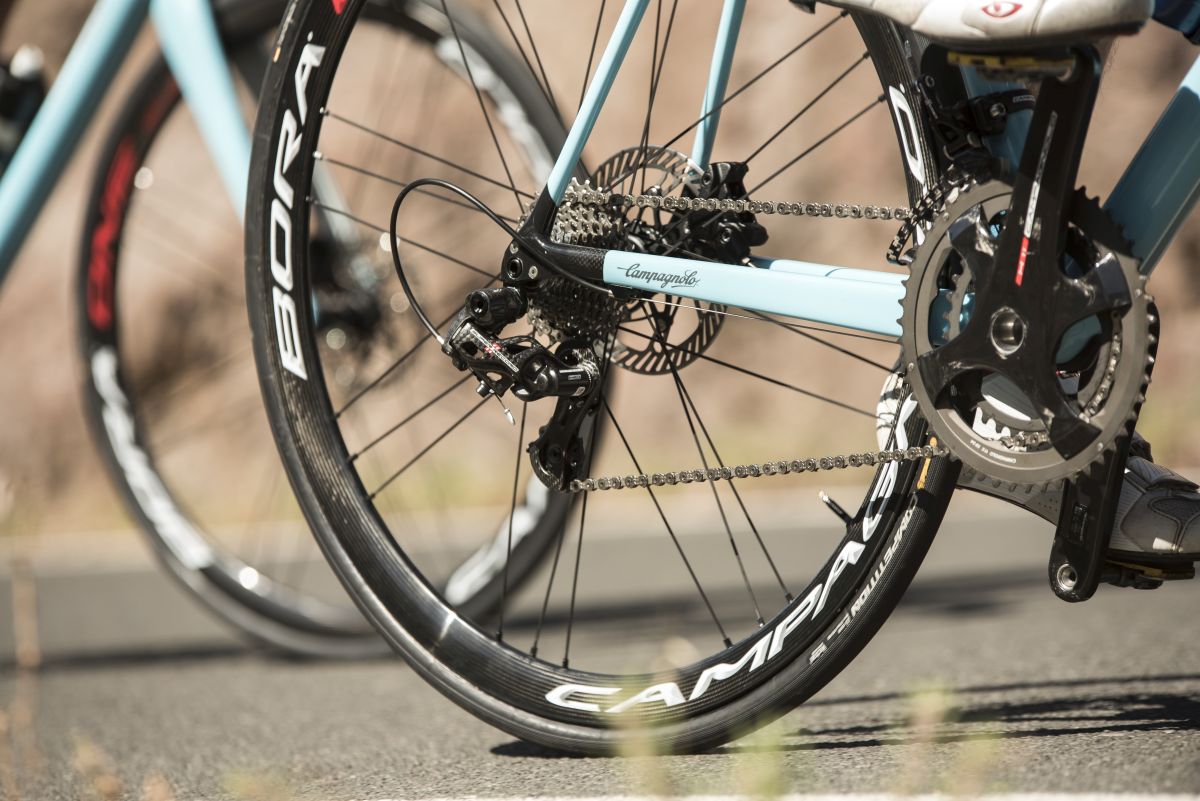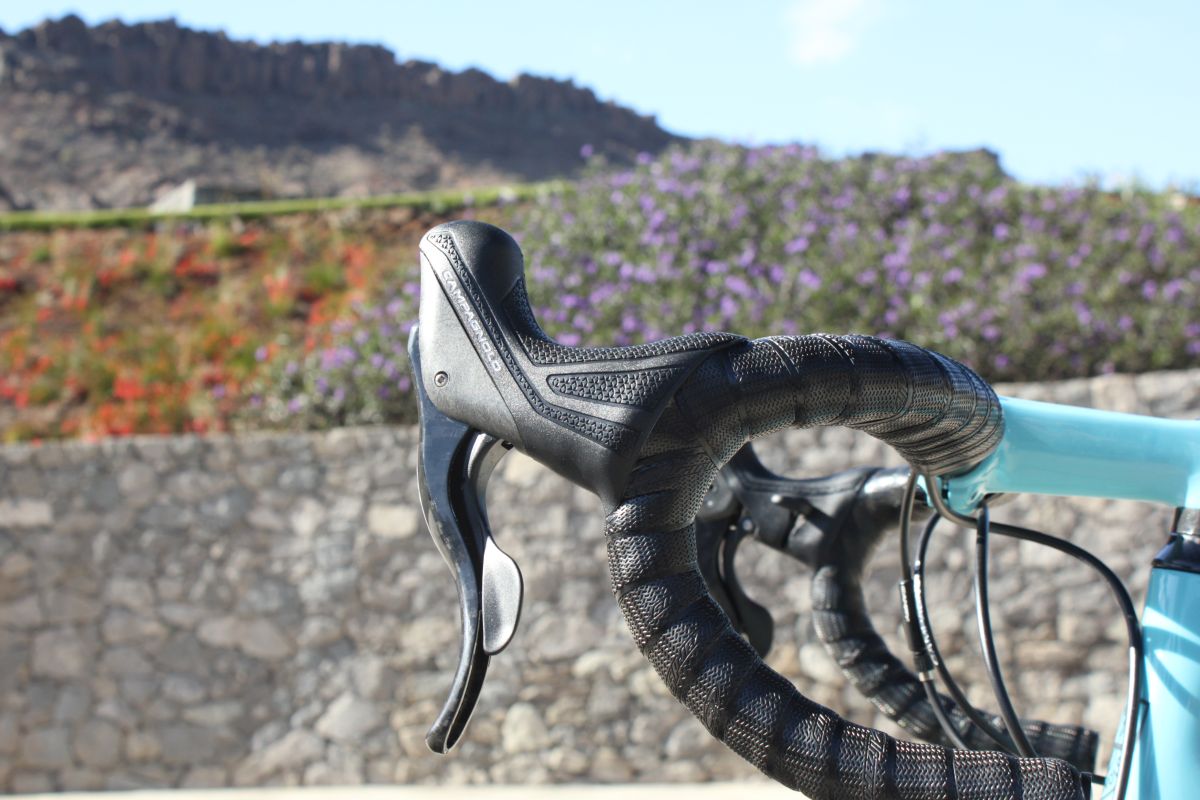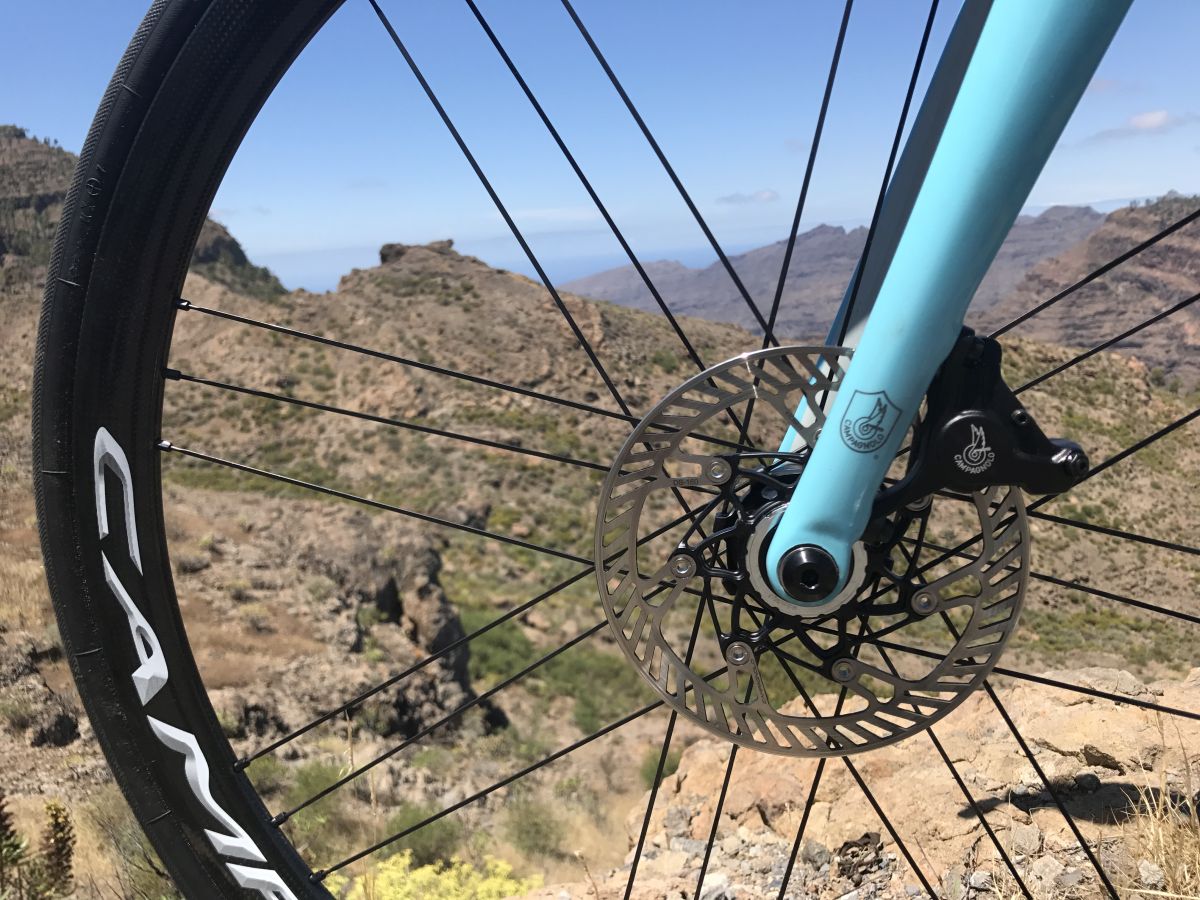Debut of the new Campagnolo H11 disc brakes
All the details you need to know about Campy's hydraulic disc brakes

After three years of development, the Campagnolo H11 disc brakes have been released. At a recent Campy press camp on Gran Canaria in the Canary Islands, the Italian bike components company revealed the finer details of the new system. There will be two Campagnolo H11 levers. Once which is compatible with Super Record EPS and Record electronic groupsets while H11 mechanical levers turn Super Record, Record and Chorus into hydraulic disc platforms. Potenza gets its own disc-brake system with different crank and levers but shares same master cylinder, rotors and calipers as H11.
The move to release disc brakes to the general public comes before most professional riders have used the technology and before the UCI has approved the discs beyond the testing phase. Campagnolo looks to the needs of their professional riders when developing new products but their disc brakes have yet to see the road in WorldTour races because of various logistical and safety concerns. “The pressure pro riders put on the product can be reproduced in the testing lab but of course it is not the same thing,” explained Lorenzo Taxis, Campagnolo’s marketing and communications director. All of Campagnolo’s key pro riders have been riding disc road bikes in training for some time now. “Almost all feedback has been really, really good,” he said.
Development of the Campagnolo H11 disc brakes
Campagnolo is a company steeped in tradition. Its components feature understated and elegant esthetics, comfortable ergonomics and precision action. The company also produced durable and reliable drivetrains and wheels. The same had to be true for the Campagnolo disc brakes, which were first seen last year. The Campagnolo H11 components stay as true as possible to the standards achieved by the Italian company’s other offerings.
While the disc brakes are a Campagnolo creation, the Italian company did consult with German company Magura in order to bring the final product to life. “The disc-brake project was somewhat outside of our original area of expertise. We had to have a steep learning curve so we partnered with Magura,” explained press manager Joshua Riddle. “They were an important partner, but it’s a 100 per cent Campy product. Magura worked on the master cylinder but the shape, size and design was done by Campy engineers.”
Campagnolo is the last of the big three groupset manufacturers to reach the market with its road-disc offering, but it was not ready to rush its disc brakes. “Our mission statement is to be the pinnacle, not the first,” explained Riddle. It was a sentiment echoed by Taxis who said, “By reaching the market the last, we need to be at the top level.”
Campagnolo H11 levers and hoods
If you were to close your eyes and grip Campagnolo’s disc brake levers, you wouldn’t know the difference from the company’s other shifters. In shifting performance, input and feel, they are unchanged. The only difference is subtle, coming from 8 mm of extra height on the top of the hoods. They are quite svelte compared with more bulky hydraulic disc offerings by other companies. Compared with other Campy hoods, the H11 have their own textured pattern. Housed inside of the levers is the master cylinder, which can be easily accessed for bleeding.
The Ergopower shifters are as comfortable and as solid as ever. The “one lever, one action” shift has stayed the same as with Campagnolo’s other Revolution 11+ offerings. You can adjust the lever on the H11. The levers also have two settings for lever pull through the adjustable modulation system: long and short. Both adjustments can be made with a 2.5 mm hex key.
Campagnolo calipers
Gone are the adapters spotted last year on Campy’s Test Lab calipers. Campagnolo has gone with an flat mount setup, which can run without adapters on any disc frame currently available using just two. The caliper has a subtle matte black finish with a white Campagnolo logo. Unfortunately, Campagnolo did not demonstrate the bleeding process for the lines that hold mineral oil. From the look of things, however, it will be a fairly straight forward operation with the ports accessible and well-placed: one on the caliper the other on the upper part of the hoods.
Safety and durability were key as Campagnolo developed its disc brakes. Managing heat was extremely important. The 22-mm pistons are made from phenolic resin, a very rigid material that does not conduct heat.
Campagnolo rotors and brake pads
The rotor shape has changed since Campy gave journalists a sneak peek in 2016. The final product is a circular rotor that comes in 160-mm front and rear and a 140-mm option for only the rear. The 160-mm rotor uses a seven-bolt setup the company calls “axial fixing system” (AFS), while a six-bolt AFS is used on the 140-mm rotor. As for the edge of the Campagnolo rotors, the Italian company is ahead of its competition. All the rotors have a rounded edges, which should allay concerns of riders in the professional peloton. Seven edge shapes were studied in a lab in Switzerland until the shape that was safest was decided upon. To the touch, it is hard to imagine the rotors being any more dangerous than any other parts of a bike.
The rotors are made entirely from steel, a material that despite being heavier than alloy, is more heat resistant, which reduces heat buildup and increases safety. The organic resin brake pad is attached to a steel frame and backed with a material Campagnolo said is borrowed from the automotive industry that is designed to reduce noise and vibrations. Campagnolo says the result is a brake pad that is extremely resistant to heat. They are held in place using magnets for faster return and better performance.
Campagnolo H11 crankset
With 142-mm rear spacing becoming standard on disc frames, Campagnolo had to tweak its crankset for the hydraulic setup. The result is the Campagnolo H11 crankset, which, in appearance and price point, is very similar to the Record crank, but is designed to a slightly different chainline without altering the Q-factor.
Pricing and weight
The disc brakes and H11 mechanical shifter are scheduled to start rolling out onto shop floors in May. The Potenza disc brakes will be available in June and the H11 EPS levers will follow in July.
Potenza DB – US$1,610.00 – 2613 g
Chorus DB – US$2,135.00 – 2319 g
Record Mech DB – US$2,385.00 – 2260 g
Record EPS DB – US$3,835.00 – 2390 g
Super Record DB – US$2,610.00 – 2228 g
Super Record EPS DB – US$4,230.00 – 2355 g
Read my first impressions from a ride on the Campagnolo H11 disc brakes paired with Super Record mechanical derailleurs and the new Bora One 35 tubular DB wheelset in the Canary Islands. Campagnolo also revealed three new disc wheelsets and the new Centaur groupset at 2017 press camp.





